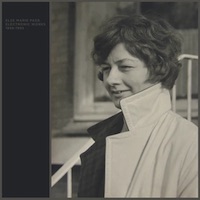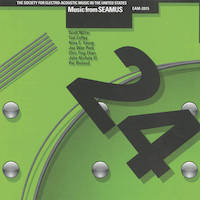EA Bucket 30.
|
Grant Chu Covell [April 2021.]
“Electronic Works 1958-1995.” Else Marie PADE: Faust Suite (1962); Lyd & Lys (1960); Syv Cirkler (1958); Etude (1962); Illustrationer (1995); Glasperlespil I (1960); Glasperlespil II (1960). Important Records IMPREC406 (2 CDs) (www.importantrecords.com). Pade (1924-2016) is considered the first Danish composer of electronic music. Isolation from an early illness attuned her to close listening. She was an active member of the Resistance and was caught and imprisoned by the Nazi occupiers. After WWII she worked with Pierre Schaeffer, and later attended the courses at Darmstadt, befriending Stockhausen and others. Stockhausen used her Glasperlespil (“Glass Bead Game”) as lecture example. Syv Cirkler (“Seven Circles”) was the first Danish electroacoustic piece performed on the radio (“There was a deluge of phone calls, panel discussions, reviewers giving it the thumbs down…”). Inspired by hearing Varèse’s Poème électronique at the 1958 Brussels World’s Fair (she also met Boulez and Pousseur there), the seven minutes are constructed serially (a seven-note row) with the tangy ring of sine tones and unexpected partials. Lyd & Lys (“Sound and Light”) employs similar sounds as Syv Cirkler. The 1962 Etude fashions short intersecting loops with pure electronic sounds and filtered sources. These early pieces can be haunting: Glasperlespil I’s wobbly repeating electronic chirping and Glasperlespil II’s flute imitations among the short reverberant bursts. In six movements, the Faust Suite is well over half an hour. Most sounds are purely electronic; there is some manipulated speech (the Dies Irae text). As the legend progresses, the timbres grow grittier. At the time, it must have been difficult to engineer such lengthy spans. The collection from the 1990’s, Four Illustrations, are not dissimilar from the earlier works. The span is large, the chosen material is positioned carefully; nothing is crowded. (Four Illustrations also appears on Dacapo 8.226544.) Less is more, and these older analogue sounds are so inviting.
“Loudspeakers.” Charles AMIRKHANIAN: Pianola (Pas de mains) (1997-2000); Im Früling (1989-90); Son of Metropolis San Francisco (1997); Loudspeakers (for Morton Feldman) (1988-90). New World Records 80817-2 (2 CDs) (www.newworldrecords.org). When I get around writing my personal history of electroacoustic music, there will be a chapter on Amirkhanian. His 1985 LP “Mental Radio: Nine Text-Sound Compositions” (CRI SD 523) opened up a whole new style of ea that worked with text and could also be humorous (catch it here). I tried to emulate Church Car (1980) and Dot Bunch (1981) but Amirkhanian set a high bar: Rhythm and pulse handled precisely, a close examination of language and phonemes, and comic timing. The same wit and precision timing appears in full force in Pianola (Pas de mains). This ten-part suite takes inspiration from player piano rolls. (Amirkhanian had a huge role in bringing Nancarrow’s music forward.) We hear mutations of Debussy, Stravinsky and others who wrote specifically for the pianola. Amirkhanian will transform and combine, often thwarting the excerpts’ tonality and sequencing. A Petroushka bit is repeated so that what was once introduction or transition becomes centerpiece; the Flight of the Bumblebee is folded upon itself, backwards, and as can be done with a piano roll, played upside down. The half-hour Im Früling harkens back to 19th-century symphonic (or pianistic) recreations of nature. Obviously, the orchestra can’t simulate the real world, but electroacoustic pieces can record nature and the composer can arrange the sounds for playback. Amirkhanian skillfully blends natural sounds and synthesized sounds. But are those real birds, chimes and thunder? As the piece progresses, the natural world retreats. Or maybe the sounds were synthetic all along. That bubbling brook might actually be a transformed bathtub draining. Son of Metropolis San Francisco is the 26-minute version of a 55-minute soundscape. Of course composers chose what to include in their music, and Amirkhanian’s choices reflect a personal and oddly juxtaposed view onto San Francisco. A scrap of a Chinese soap opera, birds and water, and electronic drones all fuse into a remarkable landscape. The title piece is an ode to Morton Feldman. Amirkhanian manipulates Feldman’s sonorous replies to interview questions (with Steve Cellum, from September 24, 1984). He did say some nutty things: “Stockhausen is just as good as Meyerbeer.” The composer’s thick Brooklyn accent turns words such as “third” and “surface” into their own particular objects. We hear Feldman’s opinionated, tenor drawl stretched, sped up and otherwise sampled in layers and canons, passing in and out of coherence. Amirkhanian transforms Feldman intoning “the piece” into a standard piano etude. Elsewhere syllables become clipped and lose grammatical meaning, then cascade into waterfalls. Towards the end, Amirkhanian gradually reveals the context for the concluding interview excerpt. Talking about Three Voices which uses a Frank O’Hara poem, Feldman remarks upon the performance setup which positions a live singer between two speakers broadcasting parts pre-recorded by the same singer. It gradually dawns that we have been listening to a memorial.
James CALDWELL: Deep Pocket Music (2015); Out of Pocket Music (2105); More Pocket Music (2001-06); Blocks Box (2017); Pocket Music (1998); Hip Pocket Music (2020); Corner Pocket Music (2018). Neuma Records 135 (1 CD) (www.neumarecords.org). Representing decades of technical tinkering, these pieces are multi-movement etudes. Originally the set began with objects found in the composer’s pockets, including objects conveyed into the studio perhaps on purpose. Later movements in the continuing series include sounds that are “larger” than the studio, or sources “found” among the composer’s files. Creating a universe from small items is vastly appealing, as is exploring the sonic facets of “coins, keys, plastic pill bottle, comb, paperback book…,” or “tennis balls banging around in a dryer, an empty Diet Coke can tipped over on a glass patio table top…,” etc. Rarely are the originals explicitly heard, they have been ingeniously transformed into scales, brushed clouds, or other predominantly unfamiliar constellations. The pieces are charmingly simple, however I suspect significant effort went into discarding the obvious, and Caldwell is right to compare the series’ breadth with Bach’s Inventions or Bartók’s Mikrokosmos.
“Catalogue de Plantes, Suite.” Bob VERSCHUEREN: Var. comps. Fuga Libera FUG 739 (1 CD) (www.outhere-music.com). Verschueren works with plants. He discovers their sonic possibilities through close manipulation and recording. These aren’t sounds of plants growing in nature, there is no wind or natural psithurism; the plants were brought into the studio and handled inside. Seeds may be rattled and shaken, leaves handled, stems tapped, rubbed or scraped. The resulting small sounds are amplified and folded together to create a relatively quiet and curious landscape. This is Fuga Libera’s second release of Verschueren’s explorations, the first was in 2009 (Fuga Libera FUG705). Here we have 17 works, or studies, created between 1995 and 2016. Aspects of several trees are captured, including maple, oak, beech, black walnut, olive, balsam and sequoia. Sugar cane sounds like a balloon being rubbed. The intimacy perplexes as it’s not evident what Verschueren is doing even though each plant sounds distinctive.
Joel GRESSEL: In Your Dreams (1999); And Its Discontent (2003); Ice Storm (2002); ShortStops (2007); The Deep End (2005; rev. 2011); This Way Lies Madness (2009); Genetic Drift (2014); The Public Option (2010); The Final Approach (2013); Losses (2006); Mixed Emotions (2019); From an Undisclosed Location (2006); Inside Job (2015); Round Trips (2015); A Trifle One-Sided (2017; rev. 2019); Under the Radar (2015); Moving On (2018). Ravello Records RR8032 (3 CDs) (www.ravellorecords.com). Welcome to the particular electroacoustic world of Joel Gressel (b. 1943). Since the 1980s, Gressel has been using his own software to compose electronic works, with consistent attention to tuning systems and a particular set of electronic instruments (timbres). These three discs offer 17 dreamy, slightly tart compositions. Each piece is symphonic in nature, although all the sounds are computer generated. Gressel’s work may suggest real instruments or identifiable objects, but everything we hear is synthetic. Admittedly, 17 pieces covering three discs can be hard to comprehend. I find these can be approached one at a time to savor details and be surprised by the quirky colors. Alternately, they can be played in large sweeps, tuning in and out as material transitions. Within each piece, ideas coalesce, sometimes repeating or transforming. Some fulminate with contrasts and follow no easily discernable structure, others can wash slowly over the listener. Titles may obliquely reference current events, but most were applied after the works were completed. In this light, these pieces could be heard as events which Gressel found interesting. To remark upon a few: In Your Dreams includes doleful washes and clicks, leveraging small events. (Most pieces are between 10 and 13 minutes.) The Final Approach has a returning gesture recalling the Drum Major’s theme from Wozzeck. I don’t hear “losses” in Losses, but enjoy the crinkly sounds suggesting analogue works of the prior decades.
“Music from SEAMUS Volume 24.” Scott MILLER: Contents May Differ (2013)a. Ted COFFEY: Petals 1, 2 & 3 (2013). Nina C. YOUNG: Metal Works – Part 1 (2014)b. Joo Won PARK: Large Intestine (2012). Chin Ting CHAN: time, forward (2012)c. John NICHOLS III: GATES (2013). Per BLOLAND: Solis-EA (2011)d. Patrick O’Keefea (b-clar), Kathleen Supovéb, Kari Johnsonc (pno), Ryan Packardd (perc). SEAMUS Records EAM-2015 (1 CD) (www.seamusonline.org). The annual compilation (from 2018) is welcome and necessary, but it does unhelpfully gravitate towards mid-length pieces, which may inadvertently disadvantage their composers. The shortish format (under 13 minutes) predisposes towards pieces which try to prove things, even though SEAMUS tries to be comprehensive and inclusive. For example, I can’t tell whether Miller’s Contents May Differ for bass clarinet and tape (11:07) is trying to be refined or is just plainly repetitive. Pieces that stood out include Bloland’s Solis-EA (10:41) for percussion and electronics whose mean-spirited distortion pushes boundaries. Joo Won Park’s cheeky Large Intestine for no-input mixer and computer is a good start (7:59), but it needs to turn the bend and run free.
Amirkhanian, Bloland, Caldwell, Chin Ting Chan, Coffey, Gressel, Joo Won Park, NC Young, Nichols, Pade, S Miller, Verschueren
[More EA Bucket, Grant Chu Covell]
[More
Amirkhanian, Bloland, Caldwell, Chin Ting Chan, Coffey, Gressel, Joo Won Park, NC Young, Nichols, Pade, S Miller, Verschueren]
[Previous Article:
Armchair Operas (and Voices) 15.]
[Next Article:
Bad Reputation]
|





